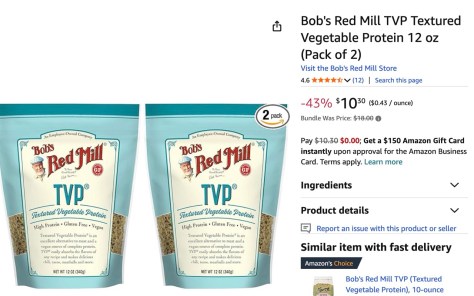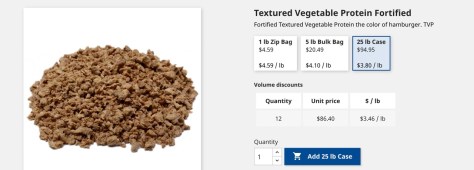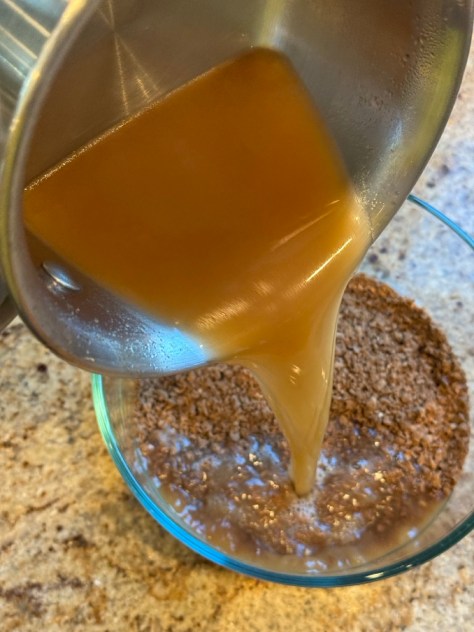Inflation and the Trump tariff taxes have impacted many areas, but price increases have been felt the most at the grocery store. Add to this beef shortages, and the cost of beef has gone through the roof.

Above, we have a “nothing special” pound of ground beef going for $9 a pound!
I have done posts on how to stretch your meat dollar. One way to to make a classic meat loaf which uses fillers like bread crumbs or oatmeal to bulk out a small amount of ground beef to proportions enough to feed a family. This is a useful strategy, but what is you could go a step further? What if you could find a very inexpensive substitute to replace 50% of your ground beef in a recipe? What if that replacement was healthy, high in protein and minerals, and offered fiber for gut health? That is today’s experiment.
TVP or textured vegetable protein was developed in the 1960s as a way to use up waste material from soybean oil production. After the oil was squeezed out of a soybean the solid matter that was left over was dehulled and turned into soybean flour. That flour was then treated to separate the protein which was heated and extruded through a mold. The extrusion process can be adjusted to make differed shapes, such as crumbles, strips, and chunks.
TVP can be made from various plants, but it is most commonly derived from soybeans. Soybean TVP is low in fats, high in complete proteins, and high in multiple minerals, including iron, magnesium, phosphorus, and potassium. Despite what you have heard, there is no need to worry about soy-based estrogens, as they are different from human estrogens.
The cost of TVP is significantly less than that of ground beef. If you buy small amounts from a boutique health store, it will be more expensive than if you buy it in bulk. Shopping on Amazon, I found drastically different prices for TVP, which is interesting, as there isn’t a lot of difference between brands, as this is a very basic food product.
I find that 1 cup (100 grams) of dry TVP, when hydrated, is about the same bulk as 1 pound of ground beef. One pound is around 450 grams, so one pound of dry TVP makes (roughly) the equivalent of 4.5 pounds of hamburger.

This Bob’s Red Mill TVP sells for $6.88 a pound, so 1 pound of hamburger equivalent (using 100 grams of dry TVP) costs around $1.52.

If you shop around, you can buy TVP in bulk. On this site, TVP is $3.80 a pound. For 100 grams of TVP (1 pound hamburger equivalent), the cost is 84 cents.

Looking for an even better bargain? This bulk bag of TVP is 50 pounds. One hundred grams of dry TVP (1 pound hamburger equivalent) costs only 37 cents! It is unlikely that you will buy 50 pounds of TVP, but it does have an extremely long shelf life. Additionally, you could buy a bag and split it in a group purchase.
TVP has essentially no flavor, and like its cousin, tofu, it picks up whatever flavor is in the dish. TVP is usually soaked in boiling water for around 10 minutes before using. I use a 1:1 ratio of TVP to water and find that adding two teaspoons of a bouillon like “Better Than Bouillon” to I cup of boiling water gives TVP a meaty taste. Vegetarians and vegans have created a variety of “soaks” for TVP that are meatless, yet add a meaty flavor. Since TVP comes in a variety of shapes it is possible to create all sorts of meat-like dishes using this ingredient.
You have probably eaten TVP many times, as it is often used as a meat extender in many frozen meals. The ingredient list on the package may say TVP, or textured vegetable protein, or TSP, or textured soy protein, or soy protein isolate, or soy chunks, or soy meat, as well as other terms. All of these names are synonyms for TVP.
TVP granules are readily available and can be found in many grocery stores. Chunks and strips can sometimes be found in health food stores and are available at online retailers.
TVP is best when combined with flavorful ingredients. Although it can stand alone as a “meat,” I find that it is easiest to use it as a substitute for 25-50% of the hamburger. In today’s example, I’ll be using it in a classic meatloaf recipe.
Let’s look at the easy process of substituting TVP for 50% of the hamburger in this meatloaf. recipe

Here you can see that 100 grams of TVP is the equivalent of one cup. As I mentioned above, I find that 1 cup of dry TVP, when hydrated, is approximately equivalent to 1 pound of hamburger.

I measured 1 cup (100 grams) of dry TVP into a bowl.

I added 1 cup of boiling beef broth (1 cup water and two teaspoons of “Better than Bouillon”), mixed, and let it sit for 10 minutes.

Here is a classic meatloaf recipe. The hydrated TVP is on the right at the 3 o’clock position. The recipe that I used had 1 pound of not too lean hamburger (don’t forget that TVP is very low in fat so you need the extra fat in the hamburger). One cup dry TVP hydrated to about 2 cups. One chopped up onion, 1 egg, 3/4 cup oatmeal, 8oz tomato sauce, 1/2 teaspoon salt, 1/4 teaspoon pepper, 1 teaspoon garlic powder. Mix it up (I use clean hands). Place in a 5″ x 9″ pan and top with catsup mixed with a little brown sugar. Bake at 350F (175C) for around 1 hour or until the internal temperature is at least 160F (71C).

Here it is out of the oven.

Served up with some mashed potatoes and vegetables.
I didn’t tell my family that I was using TVP. After they had a few bites I asked them how the meatloaf was. They all said, “Good.” I then told them that I added a special ingredient and asked them if they could guess what it was. They replied, “No, it just tastes like meatloaf.” They were surprised when I told them that 50 percent of the “meat” was TVP.
Granular/crumbled TVP can be used for many dishes beyond meatloaf. Spaghetti sauce, on top of a pizza, Sloppy Joes, chili —the list goes on. TVP chunks and strips can add variety when making TVP-containing dishes. Consider experimenting with this inexpensive, protein-rich, low-fat, high-fiber meat substitute.
Peace
Mike
Images are my own or from various websites and are used for educational purposes only.

